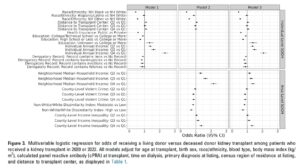Kidney transplantation is a crucial treatment that extends the life expectancy and improves the quality of life of patients with end-stage renal disease (ESRD). However, not all patients have equal access to kidney transplantation, and there are significant differences between living donor kidney transplantation (LDKT) and deceased donor kidney transplantation (DDKT). Recent studies suggest that social determinants of health (SDOH) at both the individual and community levels significantly influence the likelihood of receiving a kidney transplant, with key factors including income level, health insurance type, education level, and living environment.
This article examines how social determinants of health impact kidney transplantation accessibility and outcomes, based on recent research. It explores the significant factors at both the individual and regional levels and proposes policy recommendations to address disparities.
1. Research Overview: The Impact of Individual and Regional SDOH on Kidney Transplantation
This study analyzed 38,964 kidney transplant recipients in the U.S. between 2020 and 2022, investigating how individual- and area-level social determinants of health (SDOH) affect the likelihood of receiving LDKT versus DDKT.
Research Methodology
- Data Sources:
- Organ Procurement and Transplantation Network (OPTN)
- LexisNexis (Individual-Level SDOH Data)
- U.S. Census & County Health Rankings (Regional-Level SDOH Data)
- Analytical Models:
- Model 1: Considering individual-level SDOH only.
- Model 2: Considering area-level SDOH only.
- Model 3: Considering both individual- and area-level SDOH.
The study utilized logistic regression analysis to identify key factors determining the likelihood of LDKT and DDKT.
2. Research Findings: Key Factor Analysis
The study found that various individual- and area-level SDOH significantly impact the type of kidney transplantation patients receive.
(1) Individual-Level SDOH
① Income Level (Individual Annual Income)
- Higher income increases the likelihood of LDKT.
- Patients with an annual income exceeding $85,000 (Q4) were more than twice as likely to receive LDKT compared to those earning less than $40,000 (Q1) (OR: 2.07, 95% CI: 1.87-2.30).
② Health Insurance Type
- Public insurance users (e.g., Medicare, Medicaid) had a lower probability of LDKT (OR < 1).
- This suggests that private insurance provides better access to medical procedures, including LDKT, due to superior coverage and support programs.
③ Education Level
- Higher education increases the likelihood of LDKT.
- Patients with a college degree or higher were over 30% more likely to receive LDKT than those with only a high school diploma.
④ Economic Credit History (Derogatory Record)
- Patients with bankruptcy, eviction, or other negative financial records had a lower likelihood of LDKT.
- This indicates that economic instability affects medical decision-making and transplantation access.
(2) Area-Level SDOH
① Neighborhood Median Household Income
- Patients living in high-income neighborhoods had a higher likelihood of LDKT.
- However, individual income had a stronger impact than regional income.
② County-Level Violent Crime Rate
- Patients residing in high-crime areas were less likely to receive LDKT.
- This suggests that unstable social environments negatively affect medical accessibility.
③ Racial Segregation Index (Non-White/White Dissimilarity Index)
- In areas with higher racial segregation, the likelihood of LDKT was lower.
- This is likely due to weaker social networks and reduced donor availability in segregated communities.
(3) Model Composition and Key Findings
| Model | Key Considerations |
| Model 1 | Individual-Level SDOH Only |
| Model 2 | Area-Level SDOH Only |
| Model 3 | Both Individual & Area-Level SDOH |
Key Findings
- Income level and insurance type had the most significant impact on LDKT likelihood.
- Economic status and living environment (crime rate) were critical determinants.
- Racial disparities persisted, with Black patients being significantly less likely to receive LDKT.
3. How Does This Apply to South Korea?
Unlike the U.S., kidney transplantation in South Korea is predominantly family-based. However, social determinants of health still affect transplantation accessibility and outcomes.
- Importance of Social Support
- Kidney transplant patients rely heavily on social support from family, friends, and healthcare providers.
- Studies suggest that patients with strong social support experience better post-transplant outcomes and lower complication rates.
- Economic Factors
- Living kidney donors often face employment instability post-donation.
- Economic support for donors is necessary in South Korea as well.
- Long Transplant Waiting Time
- In South Korea, the average waiting time for a kidney transplant exceeds three years.
- Policies must address the shortage of deceased donors and improve accessibility to transplantation.
4. Policy Recommendations
Based on the study’s findings, the following policy interventions are necessary to improve equity in kidney transplantation:
- Expand Financial Support
- Provide financial aid for LDKT procedures to low-income and public insurance patients.
- Offer financial compensation to living donors to encourage donation.
- Healthcare Insurance Reforms
- Ensure equal transplantation opportunities for public insurance patients.
- Introduce tax incentives or subsidies for living donor transplants.
- Education and Awareness Programs
- Increase awareness about the benefits of LDKT.
- Develop accessible educational resources for both donors and recipients.
- Reduce Regional Healthcare Disparities
- Expand transplant centers and consultation programs in underserved areas.
- Ensure that patients in high-crime areas have access to stable healthcare services.
5. Conclusion
This study highlights that both individual and area-level social determinants of health play crucial roles in kidney transplantation access and outcomes. Income level, insurance type, education, and residential environment all significantly impact the likelihood of receiving a living donor kidney transplant.
Ensuring fair and equitable kidney transplantation opportunities requires financial support, healthcare policy reforms, educational programs, and efforts to close regional healthcare gaps.
Reference
- Mupfudze, T. G., Handarova, D., Noreen, S. M., Stewart, D. E., Mohan, S., & Schold, J. D. (2025). Influence of Individual- and Area-Level Social Determinants of Health on Likelihood of Living Versus Deceased Donor Kidney Transplantation. Kidney International Reports, 10(791-802). https://doi.org/10.1016/j.ekir.2024.12.011
